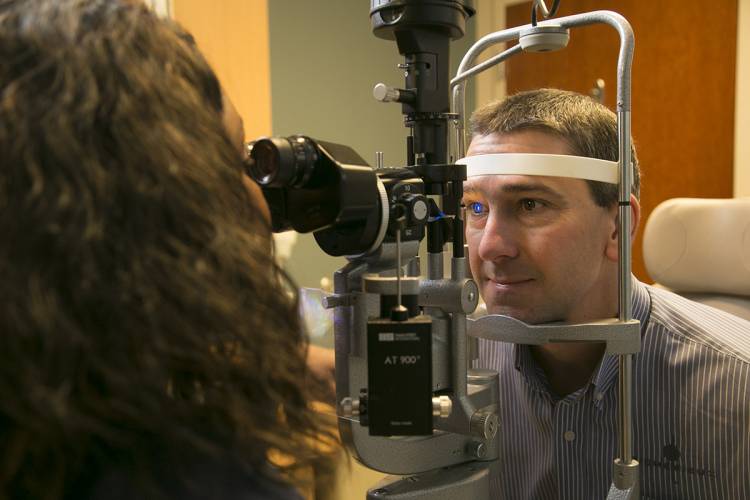3 Steps to Keep Your Eyes Healthy While Working Remotely
If increased screen time is creating discomfort, here’s what you should know

Since March, Janelle Hutchinson, lead designer and photographer with Duke University Libraries, has been working from home, putting together documents, creating graphics and communicating with colleagues online.
And Hutchinson, 31, has noticed her eyes are often dry and tired after long work sessions.
“Working from home, I am staring at my computer screen more because it’s how I do everything,” Hutchinson said. “One of the biggest things I miss about working in the library was that I had a great blend of working on the computer and interacting with people and spaces. But now it’s all on the computer.”
 Hutchinson isn’t alone as many Duke colleagues and beyond are spending more time on devices while working from home. Research by time-tracking service RescueTime showed that people in the U.S. are spending an average of 56 more minutes per day on devices after widespread COVID-19 stay-at-home orders took effect in March.
Hutchinson isn’t alone as many Duke colleagues and beyond are spending more time on devices while working from home. Research by time-tracking service RescueTime showed that people in the U.S. are spending an average of 56 more minutes per day on devices after widespread COVID-19 stay-at-home orders took effect in March.
It makes sense that the increase in screen time will lead to more people experiencing discomfort and fatigue with their eyes, according to Anupama Horne, Duke assistant professor of ophthalmology and Duke Eye Center division chief for Comprehensive Ophthalmology.
“There is such a thing as eye strain or eye fatigue which comes along with prolonged near work, or doing things such as reading or working with devices,” Horne said. “Eye fatigue and eye strain are things we hear about every day. Almost every other patient is having some of those symptoms and asks what they can do or if they’re causing long-term damage.”
Horne said prolonged exposure to screens can lead to situations such as dryness on the surface of the eye and overexertion of the muscles in and around the eye, which create uncomfortable symptoms such as blurred vision and trouble focusing.
But these conditions can be avoided with a few simple steps:
Using the 20-20-20 Rule
Large parts of Jack Edinger’s day are spent looking closely at images on his screen. As the imaging specialist with the Duke Department of Art, Art History and Visual Studies, it’s his job to ensure that the faculty and students of the department get high quality versions of the visual art pieces they study.
While he may spend hours removing dust, fingerprints and scratches from digital versions of old photos or making sure colors on reproductions of paintings match the original, Edinger, 46, also makes sure to give his eyes breaks by moving his gaze away from the computer screen periodically.
“With my routine, I’ll do the really fine detail work on one image and then I try to move on to something else,” Edinger said. “When I do graphic design, I’ll spend a lot of time working on something, but I’ll also print it out so I can look at it in a different way. That helps me give my eyes a break throughout the day.”
This matches advice that Horne gives to people experiencing eye strain or fatigue. She said tired eyes come from two main factors: infrequent blinking and overuse of the muscles in and around your eye that help it focus.
Horne recommends using the “20-20-20 rule,” which consists of taking a 20-second break every 20 minutes to stare at something roughly 20 feet away.
“It’s a way to relieve that over-focusing and give your eyes a break and blink a little bit,” Horne said.
Stay Hydrated
Horne said that one of the of the best things you can do for your eyes is blink. It seems like a no-brainer, but it’s common for people who do most of their work while looking at computer screens to unknowingly go for long periods of time without blinking.
“Sometimes you can get really in the zone and then two-and a half hours go by and I realize I have not looked away from this screen,” said Hutchinson of Duke Libraries.
Horne points out that blinking helps create tears, which lubricate the eye and keep it from feeling itchy or gritty. But as an unconscious reflex, it can be hard to remember to do it.
That’s why Horne said, if dry eyes are a problem, keeping moisturizing eye drops on hand is a safe and effective way to remedy the issue. Horne said most brands work well, provided the label says they moisturize the eye.
“They basically refresh the eyes a little bit and make up for the lack of blinking that we’re doing,” Horne said.
Get Your Eyes Checked
 Hutchinson’s vision is perfect, and she doesn’t need glasses, but each year, she schedules a visit to the eye doctor for a basic exam for peace of mind.
Hutchinson’s vision is perfect, and she doesn’t need glasses, but each year, she schedules a visit to the eye doctor for a basic exam for peace of mind.
While people with vision problems likely take regular visits to the eye doctor, for people without vision issues, periodically getting your eyes checked is a smart move. And Duke employee health insurance plans cover an annual eye exam for members regardless of whether they have vision coverage.
Horne said for most people without vision problems, it’s wise to start scheduling annual eye exams once you turn 40 to screen for problems such as glaucoma.
“For me, it’s a combination of wanting to take care of my health and the fact that I look at a screen all day and use my eyes a lot, so I need to take care of them,” Hutchinson said.
Got something you would like for us to cover? Send ideas, shout-outs and photographs using our online story idea form or write working@duke.edu.